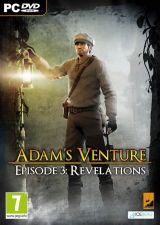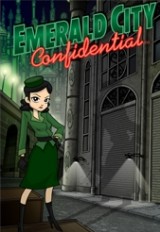Review for The Journeyman Project 2: Buried in Time
Two steps forward, one step back; one step forward, one step back (cha cha cha)...
Actually, no, this isn't fancy footwork for a new dance routine. It's a description of the uneven route taken by Presto Studios in designing Buried in Time, a sequel to their futuristic sci-fi adventure, The Journeyman Project. It's also somewhat similar to the path the player will inadvertently take through the game.
The Journeyman Project 2 is both trapped in the past and ahead of its time. Yes, I know that's shameless wordplay for a game about time travel, but it's an apt description nonetheless. Even more than its predecessor, the game manages both a stubborn adherence to convention in some ways, and an innovative, progressive approach in others. In doing so, it corrects weaknesses and mistakes of the original, and creates some all new ones in the process. Fortunately, the advances outweigh the losses for a worthy gaming experience, but it's not always a smooth ride.
Picking up shortly after the conclusion of the first game (in the year 2318, though only momentarily), Buried in Time once again features Agent 5 of the Temporal Security Agency (TSA). Though still played from a first-person perspective, this time around Agent 5 is no longer anonymous. Instead, he is introduced as Gage Blackwood—and I mean "introduced" literally. The game opens with the future Gage materializing before us (the present Gage), and hurriedly asking for our help. Apparently, in ten years he is framed for tampering with history, and the only person who can save him is us (or him… or you… sorry—pronouns are useless when speaking in fourth and fifth-person perspective). No sooner has he handed over his time travelling jumpsuit than another agent appears and whisks him back to the future.
Before hopping back in time, the first stop is to our future home to piece together the details of our wrongful arrest. Now a celebrated hero for protecting Earth's admission into the interplanetary Symbiotry of Peaceful Beings, we learn that we've left the security branch of the TSA to be part of a new historical research team. Under strict orders only to observe, our last four assignments have registered small but illegal disturbances, which can only mean that time has been altered by outside interference. To make matters worse, the Symbiotry is embroiled in a heated debate about time travelling technology, and our arrest threatens to sway the balance of the talks. Clearly, these elements are related, and the stakes are even higher than we first suspected.
The first thing you'll invariably notice about the game is its tiny viewscreen... Whoa... Deja vu from the first game! Unfortunately, it's no flashback, but a very disappointing return of windowed gaming. For an idea of how small the viewable area actually is, take a look at those screenshot thumbnails to the side—no, not that small, but if you click on one, the enlarged version is even bigger (and at the very least, the screenshot itself will put it in perspective for you). It's not an unforgivable flaw, but there's no getting around the fact that it's a detriment.
Once again filling up another large portion of the screen is the elaborate interface. The first game's interface walked the fine line between complex and complicated, but the one used in Buried in Time is altogether unwieldy. It's visually elegant, but that doesn't make it any more comfortable to operate. Far too much time is spent laboriously scrolling through menus, and you'll be required to do so constantly. Keyboard commands can help shorten the process, but that's hardly an ideal solution to a poor design.
Fortunately, what fills the viewscreen is pretty darn slick. Presto has done a terrific job of creating an engaging, fictitious world that any science-fiction fan should appreciate. The story itself is a clever take on rather standard fare, but probably won't win any converts on its own. Yet as with the first game, what The Journeyman Project 2 does most successfully is to build a believable world and entice you to explore, interact, and experiment. In a departure from the original, however, the time travelling escapades of Buried in Time take us back into real historical eras, which should help appeal to those who don't salivate over space age technology. There is a near-future space station, but we'll also take Gage to a Mayan pyramid, a besieged castle in medieval France, and a studio of Leonardo da Vinci. There's also another environment to explore late in the game quite unlike any other, but you'll have to discover that for yourself.
The graphics have undergone a thorough makeover since the original game, and the result is noteworthy. Each area is much more richly detailed, and the diverse environments are all realized convincingly. The game has also rejected its pure slideshow origins, and the movement between nodes is now fully animated with no drop-off in visual quality to break the immersion. Although still largely static, the backgrounds are interspersed with various animations that make the game feel more dynamic. On rare occasions that will include other people, but time travel doesn't permit interaction with others, so Gage is a spectator-only. Unlike many games that feel artificially desolate, however, Buried in Time smartly justifies its emptiness.
Unfortunately, getting around the game world has become more confusing and frustrating at times. Movement is still handled by clicking on directional arrows in the interface, but the sequel doesn't adopt its predecessor's tidy 90-degree node movement angles. Navigating in Buried in Time frequently involves guesswork, as the nodes may guide you through unintended twists and turns, or just a couple steps ahead. This can easily cause disorientation, which is further compounded by the look up/down arrows available at virtually every node. As a precursor to the smooth 360-degree rotational panning of games to follow, this method had good intentions, but simply doesn't work well. Many nodes require a tedious, unnatural clickfest sequence of stop, look left, up, down, forward, up, down, left, up, and down, lest you miss a rare but important clue or available movement option. The whole effect feels spasmodic.
Progression through the game is rather disjointed, as items from any one given time period will be needed in others. There's no foreseeable sequence to minimize the backtracking, and each time jump lands you at the same starting point of the respective areas, so repetition will be setting in after a few trips. At least Presto limited some (but certainly not all) of the inconvenient disc swapping by having three of the locations on the same CD.
The puzzles in the first game were decidedly easy, and the same can largely be said for Buried in Time. Once again refusing to incorporate random puzzles simply for the sake of padding game length and difficulty, Presto has done a great job of integrating the obstacles into the storyline. Some are simple inventory tasks, and others revolve around specific jumpsuit abilities, but these are interwoven with logic puzzles and clue deciphering. It's a nice mix that keeps the game moving, so don't expect a brain-straining challenge, assuming you find all the items and clues you require (which can be more problematic).
Fortunately, this game is much more ambitious than the original, and should provide at least double the amount of play time (10 hours and counting). For those wondering about the number of puzzles in the game, there are precisely twenty. No, I didn’t count—in a redesigned point-scoring and record-keeping system, the game tracks your progress through the evidence you’ve collected and puzzles completed, although these are only presented during the "game over" death screens. Yes, death. In another unwelcome holdover from the original, it's still possible to die and fail in Buried in Time—at times quite unexpectedly—so saving often is again the order of the day. Thankfully, the mission time limit has been removed, allowing you to explore at your leisure. That said, there are timed sequences in the game that are much more demanding than anything in the original, so the frustration is more confined, but still present.
Buried in Time also features a hint system, which just so happens to be the real star of the show. Forget Gage. Somewhere in your travels, you'll acquire a companion in the form (or non-form, I guess) of a wisecracking artificial intelligence named Arthur. Not only does Arthur offer some vital information periodically, but he serves as a virtual encyclopedia about the eras you visit. These comments are optional, and continually accessing them is part of the annoying interface issue mentioned above. Still, for those so inclined, it's a substantial contribution to the game. What's even better is that Arthur is always quick with the quip, and consistently funny, which is a rare commodity in gaming. Having been immersed by his creator in 20th century media, Arthur makes constant references to our own culture. Within the span of mere minutes, Arthur may do a Monty Python impersonation, quote Maxwell Smart, and parody Ginsu knife commercials, and the good times just keep coming. Sidekicks are difficult to incorporate well, and comedic ones even more, so for all the game's other achievements, Arthur has to be its masterstroke.
Strangely, although Arthur is such an integral part of the game's enjoyment, he's not featured prominently in the documentation, and the story itself doesn't encourage you to seek him out. In fact, it's entirely possible to finish a significant portion of the game without ever knowing he exists, so at the risk of creating a spoiler, I suggest you start your trek in a time period best suited to an artificial intelligence.
While the acting of some of the visible characters can best be described as spotty, the voicework is critical to making Arthur endearing, and Presto’s choice is perfect. The rest of the sound effects maintain the high standards set by the original, receiving the same level of upgrade as the graphics. Music is much more prevalent in Buried in Time, and the various scores do a nice job of setting the mood for each historical period.
Overall, Buried in Time is a solid middle installment in the Journeyman Project trilogy. It maintains a tight continuity with the original, and its ending clearly sets the stage for a follow-up. The improvements show that Presto wasn't content to rest on their laurels, and their efforts are commendable, if flawed. Unlike the previous game, Buried in Time should have a broader appeal than just science-fiction fans. There's humour, there's history, and a healthy dose of puzzle adventure that moves the franchise forward appreciably, if you can dance around the awkward missteps along the way.



























